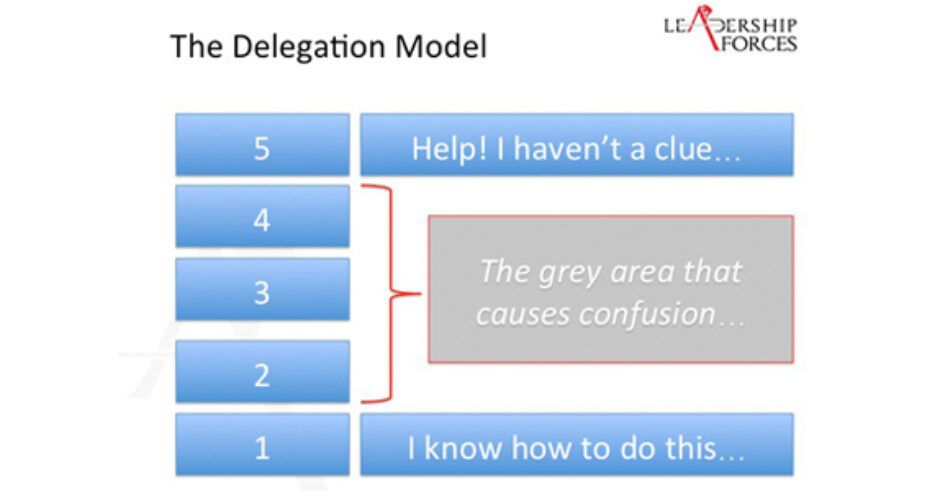Delegation is a core leadership skill.
If you can’t effectively delegate, you will hit a point where you become totally overloaded and you’ll become ineffective.
But few companies teach people how to effectively delegate. It’s one of those things that everyone assumes you pick up as you gather experience. The problem with this approach is that you’re basically using trial and error until you get it right – if you get it right.
There are two elements to effective delegation.
The first one is the team member you are delegating the task to, the second is the task itself.
The Team Member
In any team, there will be a combination of new starters, experienced individuals and everyone in-between.
The Situational Leadership® Model developed by Paul Hersey and Ken Blanchard is useful in helping a leader understand where his team members are in their development. The model places people into four categories and explains how leaders have to adjust their style depending on where the person fits into the model. It’s a very useful approach in helping people to understand the individuals in their team.
Broadly speaking, people move through the model below from stages one to four.
The leader has to adjust the level of direction and support in order to get the best out of the individual.
Problems arise when leaders don’t change their approach to suit the person that they’re dealing with. If a leader has a ‘one size fits all’ leadership style, they will struggle to get the best out of their people.
If they have a natural tendency to want to get into the detail, the people at stage one will probably respond positively whereas the people at stage four will feel like they’re being micromanaged. If they like to think of themselves as ‘strategic thinkers’ or they’re bored by details, the people at stage four might prefer it but those at stage one will probably feel unsupported and exposed.
I am generalising here but you get the idea.
The leader has to change their style and behaviour in accordance with the individual that they’re working with. The one size fits all approach doesn’t work.
Take this model and think about your own team.
Where would you put people?
Which boxes would your team members fit into?
The goal is to have a healthy spread across all four boxes. If you have too many people in stage one, you are going to have to spend a lot time developing them. If you have too many people in stage four, they’re at risk of boredom because there probably isn’t enough challenging work to go around. The other issue is that they are likely to compete internally because there are limited slots available for promotion with many people ‘ready for step-up’.
If you are leading a group of team leaders, consider the spread of experience in the teams. If a team leader is overloaded with people at stage one, his team will not perform as well as someone who has plenty of people in stage four.
The Task
The next thing to consider is the task itself.
Some tasks will be easy to delegate. They will be comfortably within the remit of a subordinates job description. These are the level one tasks. At the other end of the spectrum are the tasks or situations that people have no idea how to deal with. These are the things that they cannot do because they don’t have the experience or the authority to make the right call. These are the level five tasks.
The problems come in the middle.
What defines a two, a three and a four? Who defines it?
How does time – or lack of time – impact the situation?
It doesn’t really matter how you define a two, three or four or what level of control a leader is comfortable relinquishing.
What matters is that leaders have the conversation with their team members.
This gives people clear boundaries and a safe space within which to operate. It also helps the leader because it frees them up from hearing about all the details that they don’t need to know about. This approach provides a common language that leaders and team members can use to communicate about tasks.
If I am in a leadership position, I could ask someone to tell me what level they think an issue is and why. This creates an opportunity for me to coach them based on my comfort level for how much control I am willing to share.
The following picture is an example of how a team might use the model.
Initially, there will be team members that treat ones as if they were fives. They need to be coached to make decisions themselves. This tool provides the language to make it easier to coach them.
There will be team members who treat fives as if they were ones. These people have the potential to go rogue. You need to be careful with people who behave like this because their behaviour has the potential to create problems that ‘snowball out of control.’
Delegation is a Skill
Delegation is an important leadership skill. If you fail to delegate effectively, you’ll be less productive as a leader and be unable to focus on the longer-term issues that need your attention. From the perspective of your subordinates, it will feel like you don’t trust them and they won’t get given the challenging tasks they need to further their development.
The one-size fits all approach to delegation doesn’t work.
Use this approach to successfully navigate the delegation challenge ensuring you pick the right individual to do the right task.
The long-term impact is that you’ll develop your subordinates and create the space for you to think strategically and long-term. Who wouldn’t want that?!
The Business Transformation Network has posted this article in partnership with the Leadership Forces blog: http://www.leadershipforces.com/art-delegation/











